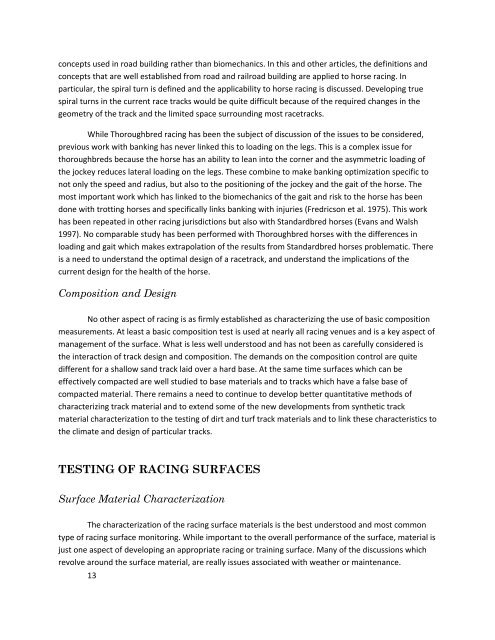Retired Racehorses
tfrr_reportandappendicesfinal
tfrr_reportandappendicesfinal
- No tags were found...
You also want an ePaper? Increase the reach of your titles
YUMPU automatically turns print PDFs into web optimized ePapers that Google loves.
concepts used in road building rather than biomechanics. In this and other articles, the definitions and<br />
concepts that are well established from road and railroad building are applied to horse racing. In<br />
particular, the spiral turn is defined and the applicability to horse racing is discussed. Developing true<br />
spiral turns in the current race tracks would be quite difficult because of the required changes in the<br />
geometry of the track and the limited space surrounding most racetracks.<br />
While Thoroughbred racing has been the subject of discussion of the issues to be considered,<br />
previous work with banking has never linked this to loading on the legs. This is a complex issue for<br />
thoroughbreds because the horse has an ability to lean into the corner and the asymmetric loading of<br />
the jockey reduces lateral loading on the legs. These combine to make banking optimization specific to<br />
not only the speed and radius, but also to the positioning of the jockey and the gait of the horse. The<br />
most important work which has linked to the biomechanics of the gait and risk to the horse has been<br />
done with trotting horses and specifically links banking with injuries (Fredricson et al. 1975). This work<br />
has been repeated in other racing jurisdictions but also with Standardbred horses (Evans and Walsh<br />
1997). No comparable study has been performed with Thoroughbred horses with the differences in<br />
loading and gait which makes extrapolation of the results from Standardbred horses problematic. There<br />
is a need to understand the optimal design of a racetrack, and understand the implications of the<br />
current design for the health of the horse.<br />
Composition and Design<br />
No other aspect of racing is as firmly established as characterizing the use of basic composition<br />
measurements. At least a basic composition test is used at nearly all racing venues and is a key aspect of<br />
management of the surface. What is less well understood and has not been as carefully considered is<br />
the interaction of track design and composition. The demands on the composition control are quite<br />
different for a shallow sand track laid over a hard base. At the same time surfaces which can be<br />
effectively compacted are well studied to base materials and to tracks which have a false base of<br />
compacted material. There remains a need to continue to develop better quantitative methods of<br />
characterizing track material and to extend some of the new developments from synthetic track<br />
material characterization to the testing of dirt and turf track materials and to link these characteristics to<br />
the climate and design of particular tracks.<br />
TESTING OF RACING SURFACES<br />
Surface Material Characterization<br />
The characterization of the racing surface materials is the best understood and most common<br />
type of racing surface monitoring. While important to the overall performance of the surface, material is<br />
just one aspect of developing an appropriate racing or training surface. Many of the discussions which<br />
revolve around the surface material, are really issues associated with weather or maintenance.<br />
13


